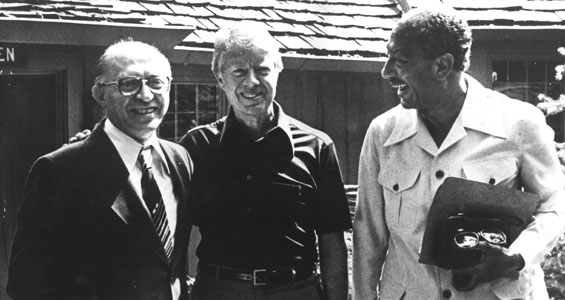Timeline: US-Egypt relations
Key dates in US-Egypt relations.

 |
| Sadat’s ties with the US marked a change of direction away from the Soviet Union [Getty Images] |
1943: While Egypt was still under British occupation, Franklin Roosevelt becomes the first US president to visit the country.
He visited it twice that year for the first and second Cairo Conferences. Both meetings, devoted to discuss the second world war, were also attended by Winston Churchill, the UK prime minister.
1945: Roosevelt visits Egypt for the third time. This time he meets Abd al-Aziz Al Saud, the king of Saudi Arabia, on board USS Quincy. The meeting establishes the US-Saudi alliance.
1952: The pro-West Egyptian monarchy was abolished after military officers led by Mohamed Nagib and Jamal Abd al-Nasir are swept to power on the wave of pan-Arab nationalism.
1953: Egypt-US relations have their first setback when the new republic turns down a US request to sign a security pact in return for arms sales.
1954: Jamal Abd al-Nasir becomes president of Egypt.
1956, July: Egypt refuses Western terms to finance a major dam in its south. Nasir nationalises the Suez Canal in order to secure more money for the dam in a move that alarms the US and other Western nations.
1956, December: The US refuses to join Britain, France and Israel in their attack on Egypt following the decision to nationalise the Suez Canal.
The Soviet Union supports Egypt during the Suez Crisis and Cairo becomes the main ally of the Soviets in the Middle East.
1967: Israel launches war on Egypt and other Arab states. Israeli forces rout Arab armies in six days. Egypt cuts ties with the US for taking Israel’s side.
1970: Nasir dies. Anwar al-Sadat takes over.
1972: Sadat expels Soviet experts from Egypt.
1973: Sadat orders a war against Israel.
1974: Egypt restores ties with the US. Richard Nixon, the US president, visits Egypt. Sadat considers Nixon’s visit to be the start of a new era in Egypt-US friendship.
1977: Sadat makes his controversial visit to Israel. US hails the move and US-Egyptian relations enter a new era.
1978: US hosts Egyptian-Israeli talks at Camp David.
1979: Egypt and Israel sign the first peace treaty between Israel and an Arab country.
As an incentive for Egypt to sign the accords, Washington promises substantive aid packages for Egypt, including military aid that continues today.
1981: Sadat expels the last remaining Soviet experts in Egypt. Soviet diplomats and media staff are also expelled. The Soviet Union responds by expelling Egyptian diplomats.
1981, October: Islamists resentful of Sadat’s peace with Israel assassinate him during a military parade. Husni Mubarak succeeds him.
1990: Iraq invades Kuwait. Egypt joins US-led forces in the first Gulf War to drive Iraq out of Kuwait.
1991: Following the Gulf War, Egypt emerges as the main US ally in the Middle East and also as the major peace broker in the region.
1999: Egypt Air Flight 990 crashes during take off from New York’s John F. Kennedy airport with many senior Egyptian officers on board.
The incident causes tension between Egypt and the US, after an US report blamed the plane’s Egyptian co-pilot for the crash.
Citing some religious phrases uttered by the co-pilot, the US report says the co-pilot committed suicide by plummeting the plane into the sea. This assumption triggered widespread resentment in Egypt.
2003: US-led forces invade Iraq. Egyptians take to the streets to condemn the war on Iraq, but the Egyptian government takes the US side and blames Iraq for the war.
2009: Barack Obama, the US president, chooses Egypt to deliver a speech to the Islamic world. Observers say Obama’s choice signalled the importance given by the US to ties with Egypt.